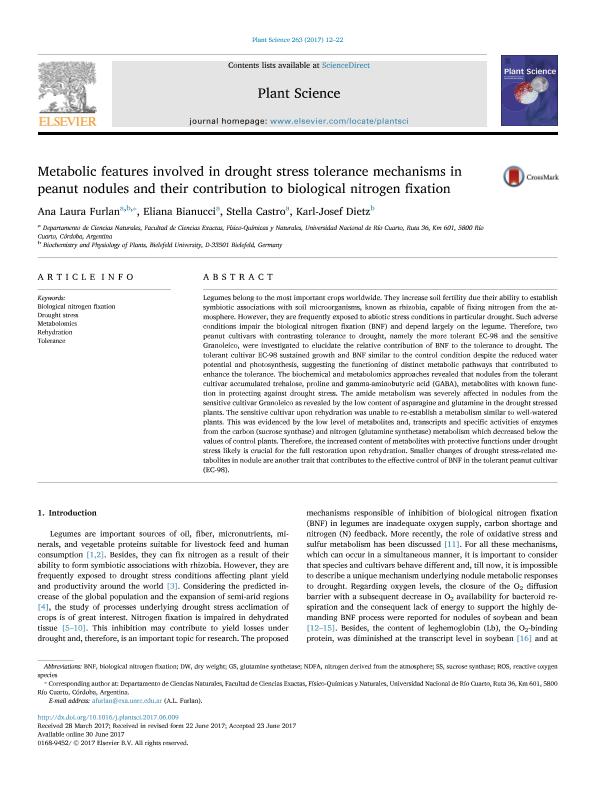Mostrar el registro sencillo del ítem
dc.contributor.author
Furlan, Ana Laura

dc.contributor.author
Bianucci, Eliana Carolina

dc.contributor.author
Castro, Stella Maris

dc.contributor.author
Dietz, Karl Josef

dc.date.available
2019-03-19T18:21:06Z
dc.date.issued
2017-10
dc.identifier.citation
Furlan, Ana Laura; Bianucci, Eliana Carolina; Castro, Stella Maris; Dietz, Karl Josef; Metabolic features involved in drought stress tolerance mechanisms in peanut nodules and their contribution to biological nitrogen fixation; Elsevier Ireland; Plant Science; 263; 10-2017; 12-22
dc.identifier.issn
0168-9452
dc.identifier.uri
http://hdl.handle.net/11336/72018
dc.description.abstract
Legumes belong to the most important crops worldwide. They increase soil fertility due their ability to establish symbiotic associations with soil microorganisms, known as rhizobia, capable of fixing nitrogen from the atmosphere. However, they are frequently exposed to abiotic stress conditions in particular drought. Such adverse conditions impair the biological nitrogen fixation (BNF) and depend largely on the legume. Therefore, two peanut cultivars with contrasting tolerance to drought, namely the more tolerant EC-98 and the sensitive Granoleico, were investigated to elucidate the relative contribution of BNF to the tolerance to drought. The tolerant cultivar EC-98 sustained growth and BNF similar to the control condition despite the reduced water potential and photosynthesis, suggesting the functioning of distinct metabolic pathways that contributed to enhance the tolerance. The biochemical and metabolomics approaches revealed that nodules from the tolerant cultivar accumulated trehalose, proline and gamma-aminobutyric acid (GABA), metabolites with known function in protecting against drought stress. The amide metabolism was severely affected in nodules from the sensitive cultivar Granoleico as revealed by the low content of asparagine and glutamine in the drought stressed plants. The sensitive cultivar upon rehydration was unable to re-establish a metabolism similar to well-watered plants. This was evidenced by the low level of metabolites and, transcripts and specific activities of enzymes from the carbon (sucrose synthase) and nitrogen (glutamine synthetase) metabolism which decreased below the values of control plants. Therefore, the increased content of metabolites with protective functions under drought stress likely is crucial for the full restoration upon rehydration. Smaller changes of drought stress-related metabolites in nodule are another trait that contributes to the effective control of BNF in the tolerant peanut cultivar (EC-98).
dc.format
application/pdf
dc.language.iso
eng
dc.publisher
Elsevier Ireland

dc.rights
info:eu-repo/semantics/openAccess
dc.rights.uri
https://creativecommons.org/licenses/by-nc-sa/2.5/ar/
dc.subject
Biological Nitrogen Fixation
dc.subject
Drought Stress
dc.subject
Metabolomics
dc.subject
Rehydration
dc.subject
Tolerance
dc.subject.classification
Otras Ciencias Biológicas

dc.subject.classification
Ciencias Biológicas

dc.subject.classification
CIENCIAS NATURALES Y EXACTAS

dc.title
Metabolic features involved in drought stress tolerance mechanisms in peanut nodules and their contribution to biological nitrogen fixation
dc.type
info:eu-repo/semantics/article
dc.type
info:ar-repo/semantics/artículo
dc.type
info:eu-repo/semantics/publishedVersion
dc.date.updated
2019-03-18T20:14:01Z
dc.journal.volume
263
dc.journal.pagination
12-22
dc.journal.pais
Irlanda

dc.description.fil
Fil: Furlan, Ana Laura. Universitat Bielefeld; Alemania. Universidad Nacional de Río Cuarto; Argentina
dc.description.fil
Fil: Bianucci, Eliana Carolina. Universidad Nacional de Río Cuarto; Argentina
dc.description.fil
Fil: Castro, Stella Maris. Universidad Nacional de Río Cuarto; Argentina
dc.description.fil
Fil: Dietz, Karl Josef. Universitat Bielefeld; Alemania
dc.journal.title
Plant Science

dc.relation.alternativeid
info:eu-repo/semantics/altIdentifier/url/https://www.sciencedirect.com/science/article/pii/S0168945217302698
dc.relation.alternativeid
info:eu-repo/semantics/altIdentifier/doi/http://dx.doi.org/10.1016/j.plantsci.2017.06.009
Archivos asociados
